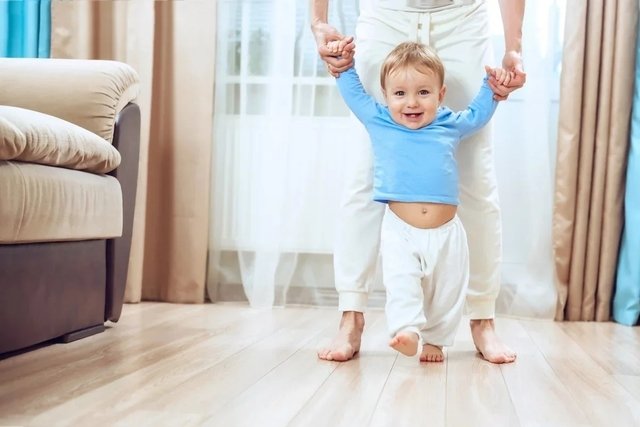The baby can start walking alone around 9 months of age, but the most common thing is for the child to start walking when they turn 1 year old. However, it is also completely normal for the baby to take up to 18 months to walk without this being any cause for concern.
Parents should only be concerned if the baby is over 18 months old and shows no interest in walking or if, after 15 months, the baby also shows other developmental delays such as not being able to sit or crawl, for example. In this case, the pediatrician will be able to evaluate the baby and request tests that can identify the cause of this developmental delay.
All newborn babies up to 4 months old, when held by the armpits and with their feet resting on any surface, look like they want to walk. This is the gait reflex, which is natural in humans and tends to disappear after 5 months.

Tips to encourage first steps
Some games and techniques can be used to help the baby take his first steps, such as:
1. Hold the baby’s hands when he is standing
To help the baby take his first steps, you can place the baby standing on the floor and support him with your hands, encouraging him to walk with small steps. It is important to be careful not to tire the baby too much and not to strain the shoulder joints by pulling the baby too hard or too fast for him to walk.
2. Placing a toy on the end of the sofa
Another good option is to place an attractive toy in the crib, on the sofa or on a side table to make the baby feel attracted to the toy and try to reach it by walking. It is important to help the baby get up, support him and encourage him to walk, which can be done by moving the toy to get the baby’s attention.
3. Laying the baby on his or her back
Lay the baby on his or her back, whether in bed or crib, and place your hands on the child’s feet in a way that encourages the child to exert force to push their hands upwards. This can be done by applying force to both feet at the same time or alternating to independently stimulate movement of each leg.
This way, it is possible to stimulate the baby’s legs, ankles, knees and hips, by simulating the movements of walking.
4. Offer toys that can be pushed with the foot
Giving the baby toys that can be pushed with the foot, such as a supermarket cart or a doll, for example, is a good option to encourage the baby to walk, as this way it is possible to stimulate balance and movement of the legs, in a which are strengthened each time there is an effort to push.
5. Calling the baby to try to walk
Calling your baby by name can also help encourage him to walk. It is important to keep a tender look and joy on your face, so that the baby feels safe. As your baby can fall, it might be a good idea to try this game on the grass, so that if he falls, he is less likely to get hurt.
Check out more games that help your baby’s development in this video:
Care to protect a baby who is learning to walk
A baby who is learning to walk should not use a walker, as this equipment is contraindicated as it can harm child development, causing the child to walk later. Understand the harms of using a classic walker.
When the baby is still learning to walk, he can walk barefoot indoors and on the beach. On colder days, non-slip socks are a great option because their feet don’t get cold and the baby feels the floor better, making it easier to walk alone.
Once he has mastered the art of walking alone, he will need to use suitable shoes that do not harm the development of his feet, providing more safety for the child to walk. The shoe must be the correct size and must not be too small or too loose, to provide more stability for the baby to walk. Therefore, until the baby is walking safely, it is best not to use slippers, only if they have elastic at the back. See how to choose the ideal shoe for your baby to learn to walk.
Parents need to always accompany the baby wherever he is, because this stage is very dangerous and as soon as the baby starts to walk he will be able to reach all parts of the house, which he may not have reached by crawling. It’s a good idea to keep an eye on the stairs, placing a small gate both at the bottom and at the top of the stairs can be a good solution to prevent the child from going up or down the stairs alone and getting hurt.
Even though the baby doesn’t like being stuck in the crib or playpen, parents should limit the places where they can be. Closing the room doors can be useful so that the child is not left alone in any room. Protecting the corners of furniture with small supports is also important so that the baby does not hit his head.
When to consult the pediatrician
If after 18 months the baby does not make an effort to walk, even after stimulation, or if after 15 months the baby presents changes in development, such as not sitting or crawling, for example, it is recommended that the pediatrician be consulted.
Furthermore, if changes are observed in the baby’s legs, for example, it is important that they receive medical attention, as this could be a sign of physical malformation that makes it difficult for the baby to begin walking, and may be recommended, in some cases. physiotherapy or surgery to correct the change.
Furthermore, in the case of intellectual disability, it is common for there to be a delay in starting to walk, and it is important that the pediatrician, child psychologist and child physiotherapist are consulted regularly to correctly stimulate leg movements and walking according to each case.

Sign up for our newsletter and stay up to date with exclusive news
that can transform your routine!
Warning: Undefined array key "title" in /home/storelat/public_html/wp-content/plugins/link-whisper-premium/templates/frontend/related-posts.php on line 12
Warning: Undefined array key "title_tag" in /home/storelat/public_html/wp-content/plugins/link-whisper-premium/templates/frontend/related-posts.php on line 13



